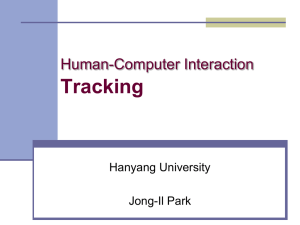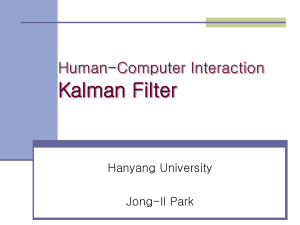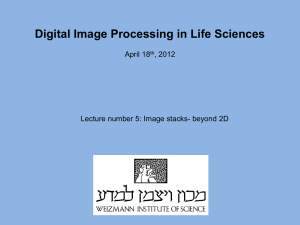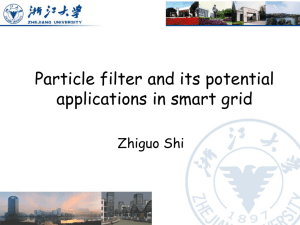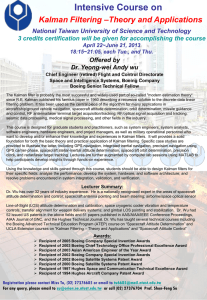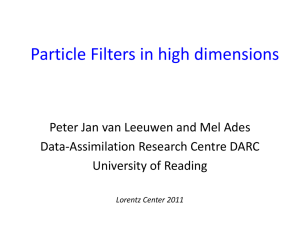PPTX, 1764 KB
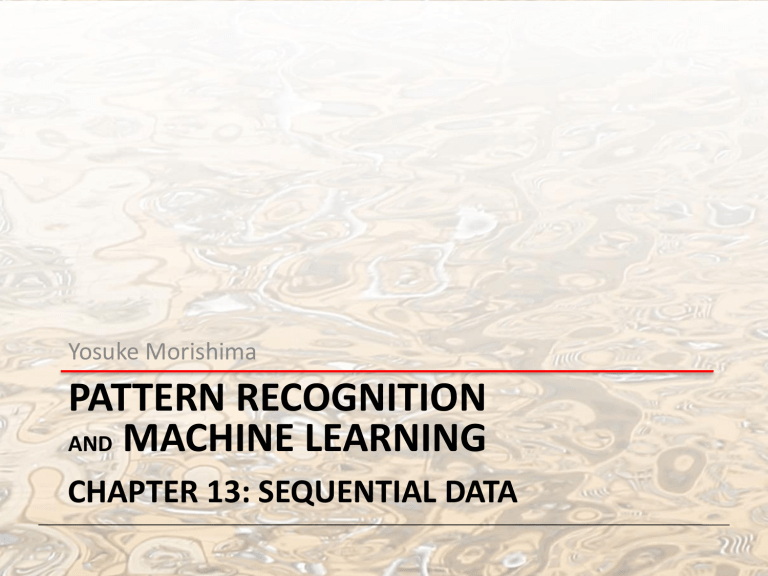
Yosuke Morishima
PATTERN RECOGNITION
AND
MACHINE LEARNING
CHAPTER 13: SEQUENTIAL DATA
Contents in latter part
Linear Dynamical Systems
What is different from HMM?
Kalman filter
Its strength and limitation
Particle Filter
Its simple algorithm and broad application
Application in Neuroscience
Dynamical Systems
State space model of Dynamical systems
Now latent variable is continuous rather than discrete z n
F ( z n
1
, w ) x n
H ( z , v ) n
State equation
Observation equation
Dynamical Systems
State space model of Dynamical systems
Now latent variable is continuous rather than discrete z n
F ( z n
1
, w ) x n
H ( z , v ) n or p ( z n
| z n
1
) p ( x n
| z n
)
Linear Dynamical Systems
Special case of dynamical systems
Gaussian assumption on distribution
Where z: Latent variable x: Observation
A: Dynamics matrix
C: Emission matrix w, v, u: Noise
Linear Dynamical Systems
Bayesian form of LDS
Since LDS is linear Gaussian model, joint distribution over all latent and observed variables is simply
Gaussian.
Kalman Filter
• Kalman filter does exact inference in LDS in which all latent and observed variables are Gaussian (incl. multivariate Gaussian).
• Kalman filter handles multiple dimensions in a single set of calculations.
• Kalman filter has two distinct phases: Predict and
Update
Application of Kalman Filter
Tracking moving object
Blue: True position
Green: Measurement
Red: Post. estimate
Two phases in Kalman Filter
Predict
Prediction of state estimate and estimate covariance
Update
Update of state estimate and estimate covariance with
Kaman gain
Estimation of Parameter in LDS
Distribution of Zn-1 is used as a prior for estimation of Zn
Predict Update
Blue: Red: Red:
Green:
Blue:
Derivation of Kalman Filter
• We use sum-product algorithm for efficient inference of latent variables.
• LDS is continuous case of HMM (s um -> integer) where
Sum-product algorithm where
Solve… where (Kalman Gain Matrix)
What we have estimated?
Predict:
Update:
What we have estimated?
Prediction error
Predict:
Update:
Predicted mean of Zn Predicted mean of Xn
Observed Xn
Parameter Estimation with EM algorithm
• E step: Given , run the inference algorithm to determine distribution of latent variable where
• M step: Given , maximize the complete-data log likelihood function wrt q
Where
Limitation of Kalman Filter
• Due to assumption of Gaussian distribution in KF,
KF can not estimate well in nonlinear/non-
Gaussian problem.
• One simple extension is mixture of Gaussians
• In mixture of K Gaussians, is mixture of K
Gaussians, and will comprise mixture of K n
Gaussians. -> Computationally intractable
Limitation of Kalman Filter
• To resolve nonlinear dynamical system problem, other methods are developed.
• Extended Kalman filter: Gaussian approximation by linearizing around the mean of predicted distribution
• Particle filter: Resampling method, see later
• Switching state-space model: continuous type of switching HMM
Particle Filter
• In nonlinear/non-Gaussian dynamical systems, it is hard to estimate posterior distribution by KF.
• Apply the sampling-importance-resampling (SIR) to obtain a sequential Monte Carlo algorithm, particle filter.
• Advantages of Particle Filter
• Simple algorithm -> Easy to implement
• Good estimation in nonlinear/non-Gaussian problem
How to Represent Distribution
Original distribution
(mixture of Gaussian)
Gaussian approximation
Approximation by PF
(distribution of particle)
Approximation by PF
(histogram)
Where’s a landmine?
Use metal detector to find a landmine (orange star).
Where’s a landmine?
Random survey in the field (red circle).
The filter draws a number of randomly distributed estimates, called particles. All particles are given the same likelihood
Where’s a landmine?
Get response from each point (strength: size).
Assign a likelihood to each particle such that the particular particle can explain the measurement.
Where’s a landmine?
Decide the place to survey in next step.
Scale the weight of particles to select the particle for resampling
Where’s a landmine?
Intensive survey of possible place
Draw random particles based upon their likelihood (Resampling).
High likelihood -> more particle; low likelihood -> less particle
All particle have equal likelihood again.
Operation of Particle Filter
Algorithm of Particle Filter
• Sample representation of the posterior distribution p(z n
|X n
) expressed as a samples {z
(l) n
} with corresponding weights {w (l) n
}. where
• Draw samples from mixture distribution where
• Use new observation x n+1 to evaluate the corresponding weights .
Limitation of Particle Filter
• In high dimensional models, enormous particles are required to approximate posterior distribution.
• Repeated resampling cause degeneracy of algorithm.
• All but one of the importance weights are close to zero
• Avoided by proper choice of resampling method
Application to Neuroeconomics
Estimation of Q value (latent variable) in reward tracking task
P rew
(L)-P rew
(R)
Samejima, Science 05
Model framework a
: learning rate g
: discount factor b
: temperature parameter
Q: action value a: action r: reward
Estimation of Q
Demonstration
• Estimation of Q value in reward seeking task
Code is provided by Kazu Samejima
• Comparison of performance btw with/without resampling.
Code is provided by Klaas Enno Stephan
